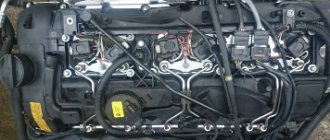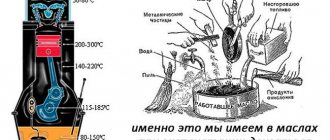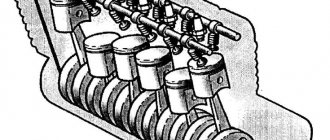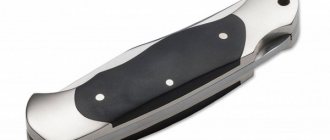The history of the automobile internal combustion engine
The first prototypes of piston internal combustion engines were created at the end of the 18th century.
In the middle of the 19th century. operating Lenoir gas engines appeared, which later replaced units designed by Nikolaus Otto. The classic gasoline engine was created by Gottlieb Daimler and Wilhelm Maybach in 1885, and a year later the first car hit the road.
Most powerful 4-cylinder engine
The 2.0-liter 4-cylinder turbocharged engine from Mercedes-Benz AMG, which powers the CLA-Class, A-Class and GLA-Class, produces 357 horsepower. This figure is impressive, but it is not the most powerful in history. In 2014, a 4-cylinder engine with 440 horsepower was developed specifically for the Mitsubishi Evolution X.
Factors affecting the power of internal combustion engines
The power of internal combustion engines is influenced by:
- Cylinder volume a and indicator pressure on the piston. As the parameters increase, the dimensions and weight of the power plant increase.
- The quality of filling the combustion chamber with the working mixture. To improve performance, 4- and 5-valve gas distribution schemes are used.
- Number of cycles . 2-stroke engines have the greatest theoretical output, but due to the loss of part of the working mixture, the advantage over 4-stroke engines does not exceed 60% . On machines, the 2-stroke circuit is not used due to the impossibility of complying with environmental requirements and high fuel consumption.
- Crankshaft rotation speed. As it builds up, the power increases.
- Density of supplied air . To increase the parameter, compressors are used.
Rating of cars with the most powerful engines
The top cars with the most powerful piston power plants included the following products:
- manufacturers Porsche, Bugatti and Lamborghini , part of the Volkswagen AG ;
- German factories Mercedes-Benz and BMW , which are in constant competition;
- Japanese concern Nissan ;
- American enterprises Dodge and Chevrolet ;
- small American and European companies Hennessey , Ultimate , Locus and Koenigsegg , which assemble sports cars using original components.
Porsche 9FF F97 A-Max
In 2013, 9FF introduced a modified Porsche 997 with a 4.2-liter petrol engine with opposed cylinders and a turbocharger. Improvements affected the piston group and gas distribution mechanism, power increased to 1400 hp. With. During test runs, the 2-door coupe accelerated to 403 km/h, acceleration to “hundreds” took about 2.4 seconds. The car was built in 1 copy; modification kits were not supplied for sale.
Porsche Carrera GT-9
In 2008, a single copy of the Porsche Carrera GT with a 900-horsepower engine with a volume of 5733 cm³, equipped with a supercharger and an air intercooler.
The modernization made it possible to increase the maximum speed to 390 km/h , and the acceleration time to “hundreds” did not exceed 3.2 seconds.
The engine was located in the center of the car body, torque was transmitted to the rear wheels. The modernization work was carried out by the 9FF studio, which specializes in fine-tuning Porsche products.
Nissan GT-R Switzer R1K-X Red Katana
Nissan GT-R sports cars from the Switzer studio are equipped with a 1400-horsepower unit. The cylinder block has a volume of 3799 cm³, a supercharger with a compressed air intercooling system is provided.
The developer claims a maximum speed of 400 km/h, which is forcibly limited due to the risk of tire destruction.
The automatic transmission provides acceleration to 100 km/h in 2.5 seconds. The first copy of the R1K-X Red Katana was assembled in 2013; the manufacturer did not announce the exact number of modified vehicles.
Hennessey Venom GT Spyder
Venom GT cars were produced by the American manufacturer Hennessey. In total, 6 copies of cars with coupe and roadster bodies were collected. In the front part there was a 7 liter General Motors engine with a supercharger, which made it possible to increase the power to 1451 hp. s., and torque up to 1745 N*m. A 6-speed manual gearbox from Ricardo plc was used, which ensured a speed of 427 km/h. The result was obtained during an independent test by representatives of Racelogic from the USA.
Bugatti Chiron
After joining the Volkswagen AG group, Bugatti was able to begin production of new hypercar models. In 2021, based on the Veyron, a Chiron model was created with a 1500-horsepower engine and an automatic transmission with 2 clutches. The car is capable of accelerating to 420 km/h , and the declared resource of the power plant exceeds 300 thousand km (subject to compliance with maintenance regulations). The manufacturer expects to produce 500 copies of the Chiron with a 2-door coupe body, with a starting price of 1.9 million pounds sterling.
.
Ultimate Aero TT
Aero TT coupe was assembled in small batches by the American company Shelby Super Cars using components from production cars. The engine was borrowed from Chevrolet sports cars.
Power reached 921 hp. With. through the use of a mechanical compressor and a racing fuel mixture with an octane rating of 104 units.
A total of 25 Aero TT cars were built, capable of accelerating to 412 km/h and accelerating from zero to 100 km/h in 2.8 seconds.
Dodge Challenger
Dodge Challenger coupes are equipped with V-shaped 8-cylinder units of the Hemi series with a supercharger driven by the crankshaft. Engine power depends on the settings of the control unit and boost pressure.
The SRT Hellcat modification is equipped with a 717-horsepower engine that develops torque up to 880 Nm.
The buyer can order the car with a 6-speed manual transmission or an 8-speed automatic unit that supports additional operating modes.
Chevrolet Corvette
Chevrolet Corvette sports cars have been present in the production program of the American concern since the mid-50s. last century. From 2021, the C8 generation body with a V-shaped engine with a mechanical compressor is offered. The power of the 6.2-liter unit reaches 502 hp. pp., only an 8-speed automatic transmission is available. Based on the previous generation, the ZR1 version was produced, featuring a 755-horsepower engine.
Locus Plethore
The Locus Plethore prototype was presented in mid-2007, the technology was developed by the Canadian companies HTT Automobile and Locus. The engine is based on a production 8.2-liter GM Performance block with a mechanical supercharger. The engine developed a power of 1300 hp. With. and worked with a 6-speed manual transmission developed by GM. The maximum speed is stated at 385 km/h, the car did not reach mass production.
Nissan GT-R AMS Alpha 12
Modified by AMS, the 2-door Nissan GT-R received a 4-liter engine with compressors, developing 1500 hp. With. The power reserve allowed to increase the maximum speed to 370 km/h. The first copy of the modernized sports car was presented in 2011; the exact number of cars assembled is unknown.
Lamborghini Aventador Mansory Competition
The Aventador version from the Mansory studio is distinguished by the use of a 1600-horsepower gasoline unit with a volume of 6498 cm³. The body retained the standard panels, the chassis and transmission did not undergo any modifications. According to factory data, the car can accelerate to 100 km/h in 2.1 seconds, and the top speed reaches 370 km/h .
Mercedes-Benz SLR McLaren Brabus
The sports coupe Mercedes-Benz SLR , modified by McLaren and Brabus, is distinguished by the use of a 720-horsepower gasoline engine and improved braking mechanisms. The engine has a 10-cylinder V-shaped block with a volume of 5734 cm³ and 4 turbines. Claimed straight line speed is 342 km/h and acceleration to 100 km/h takes 3.4 seconds.
BMW M5
The BMW concern's production program includes cars modified by its subsidiary BMW Motorsport. From 2021, customers are offered a 4-door sedan or station wagon with a supercharged 8-cylinder N63 engine, boosted to 600 hp. With. The car accelerates to 100 km/h in 4 seconds and reaches a speed of up to 250 km/h (when the limiter is removed, the parameter reaches 304 km/h).
Lamborghini Aventador Mansory Carbonado GT
Atelier Mansory converted single copies of the Lamborghini Aventador using carbon fiber body elements. The power of the 6.498-liter engine was increased to 1600 hp. s., which made it possible to reach speeds of up to 370 km/h. Curb weight 1555 kg, acceleration time from zero to “hundreds” was 2.1 seconds.
Dagger GT
The “paper” sports car Dagger GT was presented in 2010, but the project did not reach the construction of a prototype. The developer announced the use of a 2500-horsepower unit running on a mixture of alcohols; gasoline versions were envisaged, developing from 800 hp. With. Separate statements were made about the possibility of a 3000-horsepower modification.
Koenigsegg Regera
Launched into small-scale production in 2021, the Regera received a 1,600-horsepower supercharged engine. The power plant includes 3 electric motors with a total power of 707 hp. With. The speed reaches 410 km/h, the electric range is up to 50 km. The batteries are charged from the mains or through energy recovery during braking.
The electric power reserve of the Koenigsegg Regera is up to 50 km.
Copperhead on a Dodge SRT Viper
Dodge, a division of Chrysler Corporation, produces today's most powerful gasoline engine, which is installed in the Dodge SRT Viper sports car. The engine capacity is 8.4 liters, it can accelerate to 100 km/h in just 3 seconds, and the Copperhead power on the Dodge SRT Viper is 640 horsepower.
The engine for the car is based on the Magnum V10 engine. In its original form it was suitable for a pickup truck, but was excessively bulky for a sports car. One of the main decisions made by Chrysler Corporation when re-releasing the engine was to replace the block material from cast iron with aluminum. The weight of the motor is about 350 kg. Torque - 630 nanometers at 3600 rpm.
Leaders in engine power in the high-speed car sector
The top 3 most powerful cars included:
- experimental Pininfarina Battista with electric motors and a 2-seater coupe body with lifting doors;
- Rimac Concept Two prototype with an electric powertrain, theoretically allowing the car to accelerate to 415 km/h;
- futuristic Devel Sixteen, which is a figment of the imagination of a small company from the UAE and has not progressed beyond the static mock-up stage.
Pininfarina Battista
As part of the annual exhibition in Geneva in 2021, a prototype of the Pininfarina Battista sports coupe, equipped with an electric powertrain, was shown. The creators declared a power of more than 1900 hp. With. at a torque not lower than 2300 N*m. The maximum speed is limited by the strength of the tires at 350 km/h, and acceleration to 300 km/h takes 12 seconds. A battery with a capacity of 120 kWh provides a range of up to 450 km (without specifying the speed). Plans have been announced for the production of 150 cars, but the Pininfarina Battista is not being mass-produced as of January 2021.
Rimac Concept Two
In 2021, the Croatian company Rimac Automobili presented a prototype of an electric sports car with a 2-door coupe body and an all-wheel drive system. A separate electric motor with gearbox is used for each wheel, the total power is stated at 1914 hp. With. To power the power plant, a lithium-nickel battery is used, providing a range of up to 650 km (at a calm pace of operation). The serial production planned for 2021 has not yet begun; a number of automotive publications are skeptical about the prospects of the project.
Devel Sixteen
The fast car Devel Sixteen was presented by a group of developers from the UAE in the form of a static model in 2013. The creators talked about a hypothetical gasoline engine with a power of up to 5000 hp. s., capable of accelerating the car to 560 km/h. However, information about the location of radiators necessary to remove excess heat was not provided. It was known that work on the engine was carried out by the American company Steve Morris Engines. Prototypes of the vehicle for sea trials or the engine for bench runs never appeared.
The most powerful 8-cylinder engine
There are many V8-powered cars on the market, including the likes of the Chevrolet Corvette, Ferrari 488 or McLaren 720S. However, now the leadership belongs to the Koenigsegg Agera RS. Its 5.0-liter V8 engine produces 1,360 horsepower. But the Hennessey Venom F5 will soon hit the market, which will be equipped with a 7.4-liter V8 engine producing 1,600 horsepower.
List of the most powerful engines by number of cylinders
The ranking of the most powerful internal combustion engines includes:
- 2-cylinder FIAT Twinair , created for small vehicles of the Italian concern;
- in-line 3-cylinder Ford Ecoboost, designed for cars of classes B and C;
- 2-liter Mercedes, modified by AMG;
- in-line 5-cylinder Audi with supercharger and direct fuel injection system, designed for models with improved dynamic characteristics;
- the opposed 6-cylinder Porsche 3.8 with a compressor, installed on expensive modifications of the 911 sports cars;
- 8-cylinder small-scale Koenigsegg 5 liter engine, equipped with separate turbines for each cylinder bank;
- 10-cylinder Lamborghini , unified with the Audi 5.2 V10 unit (both brands belong to the Volkswagen AG concern);
- 12-cylinder naturally aspirated engine from the Ferrari 812 Superfast sports model;
- 16-cylinder small-scale unit from Bugatti , designed for installation on hypercars.
2 cylinders - FIAT 0.9 Twinair
The Twinair engine went into mass production in 2010 and is found under the hoods of FIAT 500C, Panda, Punto, as well as Lancia Ypsilon and Alfa Romeo MiTo. The basic version develops 85 hp. With. with a volume of 875 cm³. The block is cast from cast iron, an aluminum 8-valve head is used (without adjusting the valve timing). The manufacturer used a Mitsubishi TD02V turbocharger and a distributed injection system for gasoline grades A-95 and higher. The declared resource is 200 thousand km, which is considered the norm for small cars.
3 cylinders - Ford 1.0 Ecoboost
Ford Ecoboost unit with a volume of 999 cm³ and a power of 125 hp. With. was launched into mass production in 2012. The use of variable valve timing and a boost system made it possible to increase the torque to 170 N*m, which is achieved in the range from 1700 to 4500 rpm. The manufacturer has provided a special Overboost mode, which allows you to increase the boost pressure when you sharply press the gas pedal (for example, when overtaking) and increase the torque to 200 N*m. There are versions modified by a tuning studio, developing up to 205 hp. With. and 260 N*m without loss of resource.
4 cylinders - Mercedes-AMG 2.0
The AMG studio, which is a partner of Mercedes Benz , is engaged in the modification of cars of the German manufacturer. The upgraded liquid-cooled unit has an output of 380 hp. pp., preserving the original resource. The engine is equipped with a 16-valve aluminum head with a phase adjustment mechanism, and there is a system for reducing exhaust toxicity to the requirements of the Euro-6 standard.
The use of a turbine has led to an increase in the compression ratio; gasoline with an octane number of at least 98 units is used as fuel.
5 cylinders – Audi 2.5
The layout with 5 cylinders is rare; similar units were mass-produced by VAG and Volvo. Audi cars have in-line 2.5-liter TFSI engines with power up to 360 hp. s., equipped with supercharging and direct fuel injection. The engine has a stable torque level of 450 N*m in the range from 1600 to 5300 rpm, which ensures good dynamic characteristics of the car. The engines were equipped with a cast iron block and a 20-valve aluminum head with variable valve timing. Production ceased in 2014.
6 cylinders - Porsche 3.8
The engine is distinguished by its small height due to the opposed arrangement of the cylinders, and is designed for operation on A-98 gasoline. An electronically controlled supercharger is used to supply air to the combustion chambers. The output of the unit is 700 forces at a rotation speed of 6750 rpm. The manufacturer used a 24-valve gas distribution scheme. The toxicity of exhaust gases meets Euro-5 standards. The supercharged 3.8-liter version ceased production at the end of 2021. The successor displaces 3.7 liters and produces up to 650 hp. With.
8 cylinders - Koenigsegg 5.0
The Koenigsegg 5.0 unit is built on the basis of an 8-cylinder V-shaped block with a camber angle of 90°. Aluminum alloy is used to make the body and heads. A 32-valve gas distribution system is used with the ability to automatically adjust the intake and exhaust phases. Turbochargers are installed that create an excess pressure of 1.3 bar and allow the power to be increased to 1160 hp. With. (with a volume of 5065 cm³). The engine develops torque up to 1280 N*m in the range from 2700 to 6170 rpm and complies with Euro 6 environmental standards.
Koenigsegg engine.
10 cylinders - Lamborghini 5.2
Lamborghini petrol unit with a V-shaped block (camber angle 90°) was created in 2003 for installation on Gallardo sports cars. The engine was not equipped with compressors; the compression ratio was 12.5 units. Each cylinder had 4 valves, and a dry sump lubrication system was used to reduce the height. The units were supplied in several modifications. Power - ranging from 560 to 640 hp. With. For Audi cars, the Audi 5.2 V10 engine was offered, which is one of the Lamborghini powertrain options.
12 cylinders - Ferrari 6.5 V12
The 6.5 liter engine from the 812 Superfast will hold the record for power among naturally aspirated civilian internal combustion engines. The power unit develops 800 hp. With. at 8500 rpm, and peak torque of 718 N*m is achieved at 7000 rpm . To improve performance, an intake manifold with variable geometry and a gasoline injection system at 350 bar pressure, borrowed from naturally aspirated engines of Formula 1 racing cars, are used.
16 cylinders - Bugatti 8.0 W16
The engine has a W-shaped cylinder block with a volume of 7993 cm³ with separate heads, a geometric compression ratio of 9 units.
The use of individual compressors driven by gas turbines makes it possible to obtain a power of up to 1500 hp. With.
The unit is designed for operation on A-98 gasoline. Fuel consumption in city mode exceeds 42 liters per 100 km. The engine has a closed lubrication system with a dry sump. To maintain the temperature regime, several radiators are used (the Chiron model has 10 heat exchangers).
Cylinders and their number
To understand the enormity of the design, one can imagine that the diameter of the cylinder alone is 960 millimeters, and the piston stroke is 2.5 meters. As for the working volume of the part, it has 1820 liters. More than 100 container ships are equipped with such units, which have from 8 to 20 cylinders. Such vessels, capable of carrying cargo up to 10,000 tons, can easily reach speeds above 46 kilometers per hour.
This most powerful engine in the world, with 11 cylinders, was first built in 1997. The manufacturing company was the Japanese Diesel United. And 5 years later in Finland they announced that it was possible to produce a unit with 14 cylinders. It is this motor that remains a record to this day.











